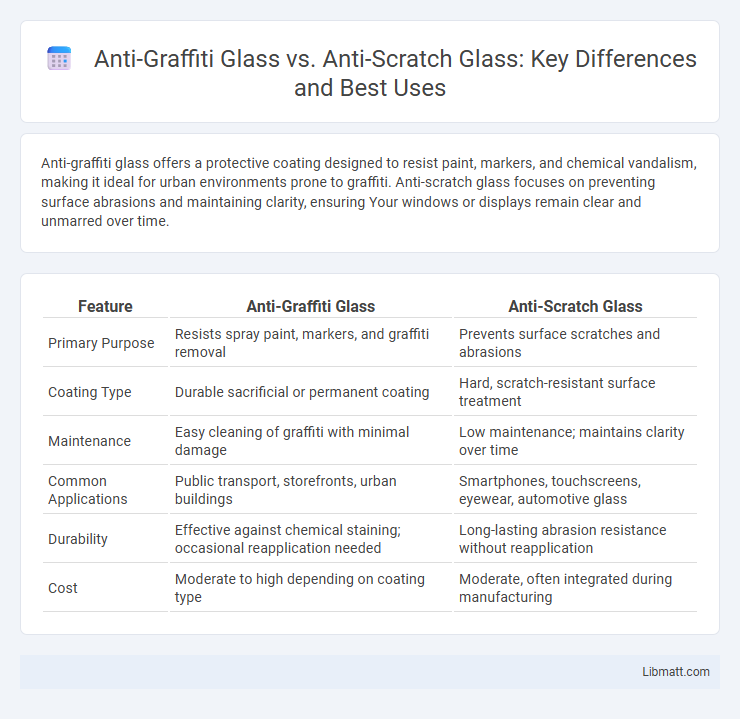Anti-graffiti glass offers a protective coating designed to resist paint, markers, and chemical vandalism, making it ideal for urban environments prone to graffiti. Anti-scratch glass focuses on preventing surface abrasions and maintaining clarity, ensuring Your windows or displays remain clear and unmarred over time.
Table of Comparison
| Feature | Anti-Graffiti Glass | Anti-Scratch Glass |
|---|---|---|
| Primary Purpose | Resists spray paint, markers, and graffiti removal | Prevents surface scratches and abrasions |
| Coating Type | Durable sacrificial or permanent coating | Hard, scratch-resistant surface treatment |
| Maintenance | Easy cleaning of graffiti with minimal damage | Low maintenance; maintains clarity over time |
| Common Applications | Public transport, storefronts, urban buildings | Smartphones, touchscreens, eyewear, automotive glass |
| Durability | Effective against chemical staining; occasional reapplication needed | Long-lasting abrasion resistance without reapplication |
| Cost | Moderate to high depending on coating type | Moderate, often integrated during manufacturing |
Introduction: Understanding Anti-Graffiti and Anti-Scratch Glass
Anti-graffiti glass is specially coated to resist paint, ink, and marker damage, ensuring easy removal of graffiti without harming the glass surface. Anti-scratch glass features a hardened layer designed to prevent abrasions and maintain clarity in high-traffic or industrial environments. You can choose between these options based on whether your priority is protecting glass from vandalism or everyday wear and tear.
Key Differences between Anti-Graffiti and Anti-Scratch Glass
Anti-graffiti glass features a durable, transparent coating specifically designed to resist paint, markers, and adhesives, enabling easy removal of graffiti without damaging the glass surface. Anti-scratch glass, however, is engineered with a hard, scratch-resistant layer that protects against abrasions from sharp objects and everyday wear. The key difference lies in their protective functions: anti-graffiti glass prevents permanent vandalism through removable coatings, while anti-scratch glass provides long-lasting surface hardness to minimize physical damage over time.
How Anti-Graffiti Glass Works
Anti-graffiti glass features a durable, transparent coating that resists paint, markers, and scratches, allowing easy removal without damaging the underlying surface. This protective layer is specially formulated to prevent graffiti from bonding permanently, making cleaning quick and effective. Your property benefits from maintaining clear, unmarked views while reducing maintenance costs and downtime.
How Anti-Scratch Glass Protects Surfaces
Anti-scratch glass protects surfaces through a durable, hard coating that resists abrasion, preventing minor scratches from everyday contact and cleaning. This specially engineered layer maintains clarity and prolongs the lifespan of the glass by reducing damage from sharp objects or rough handling. Compared to anti-graffiti glass, which targets paint and vandalism removal, anti-scratch glass primarily minimizes physical wear and maintains surface integrity.
Durability and Longevity: Which Glass Lasts Longer?
Anti-graffiti glass features a durable, sacrificial coating designed to resist paint and markers, allowing easy removal without damaging the glass surface, which can be reapplied to maintain longevity. Anti-scratch glass boasts a harder surface engineered to withstand physical abrasions, offering consistent protection against everyday wear and tear but may show damage over time depending on use intensity. Your choice depends on the specific environmental challenges, with anti-graffiti glass excelling in vandal-prone areas and anti-scratch glass providing sustained durability against mechanical impacts.
Maintenance Requirements for Each Glass Type
Anti-graffiti glass features a protective coating that simplifies cleaning and removes paint, stickers, and other vandalism with minimal effort, reducing maintenance frequency and costs. Anti-scratch glass is designed with a hardened surface to resist everyday abrasions and scuffs, but it may require occasional cleaning and inspection to maintain its scratch-resistant properties. Your choice between the two should consider whether your primary concern is graffiti removal or protection against physical wear and tear.
Cost Comparison: Anti-Graffiti vs. Anti-Scratch Glass
Anti-graffiti glass typically costs more than anti-scratch glass due to its specialized coatings that provide enhanced protection against paint and markers, making it ideal for high-vandalism areas. Anti-scratch glass is generally less expensive, designed primarily to resist surface abrasions and maintain clarity in everyday use environments. The choice between the two depends on budget constraints and the specific durability requirements of the application.
Ideal Applications: Where to Use Each Type
Anti-graffiti glass is ideal for high-traffic urban environments such as public transportation shelters, storefronts, and metro stations where vandalism is a concern, providing a protective layer that resists paint, markers, and stickers. Anti-scratch glass is best suited for applications requiring frequent cleaning or contact with abrasive materials, like touchscreen devices, display cases, and automotive windows, offering enhanced durability against surface damage. Your choice depends on whether protection against vandalism or surface wear is the primary need for the glass installation.
Environmental Impact and Sustainability Factors
Anti-graffiti glass reduces the need for harsh chemical cleaners by allowing easy removal of paint and markers, contributing to lower environmental pollution and waste. Anti-scratch glass enhances durability, extending the lifespan of windows and surfaces, which decreases the frequency of replacements and reduces material consumption. Choosing either option supports sustainability, but your selection should consider the specific environmental benefits related to maintenance and longevity.
Choosing the Right Glass for Your Project
Anti-graffiti glass features a durable coating designed to resist paint, marker, and sticker damage, making it ideal for urban environments prone to vandalism. Anti-scratch glass offers enhanced surface hardness to protect against abrasions from everyday wear and tear, suitable for high-traffic areas or commercial applications. Select anti-graffiti glass for projects requiring easy removal of graffiti and anti-scratch glass for maintaining clarity and longevity in physically demanding settings.
anti-graffiti glass vs anti-scratch glass Infographic

 libmatt.com
libmatt.com